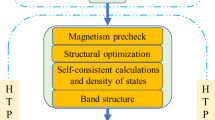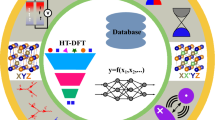Abstract
The author’s perspective on Materials Genome® is presented in this paper through several related projects. Current thermodynamic and kinetic databases of multicomponent materials consist of Gibbs energy functions and atomic mobility of individual phases as functions of temperature, composition, and sometimes pressure, i.e., with the individual phases based on crystal structures as the genome (building blocks) of materials. It is articulated that if an individual phase has its internal configurations, such as magnetic spin configurations and ferroelectric polarization, change significantly with respect to temperature, stress, and magnetic and electric fields, then those individual configurations instead should be considered as the genome of the individual phase. The “mutation” of an individual phase is governed by the entropy of mixing among the individual stable and metastable configurations, named as microstate configurational entropy, and responsible to anomalies in individual phases. Our ability to tailor the properties of those individual configurations as a function of compositions is the key for the design of materials.




Similar content being viewed by others
References
Kaufman L, Bernstein H (1970) Computer calculation of phase diagram. Academic Press, New York
United States Patent and Trademark Office (2012) Trademark Electronic Search System (TESS): Materials Genome (http://tess2.uspto.gov/). November 2012
National Science and Technology Council (2011) Materials genome initiative for global competitiveness. http://www.whitehouse.gov/sites/default/files/microsites/ostp/materials_genome_initiative-final.pdf Office of Science and Technology Policy, Washington, DC. June 2011
Kaufman L (1959) The lattice stability of metals. 1. Titanium and zirconium. Acta Metall 7:575–587
Liu ZK, Chen LQ, Spear KE et al (2003) An integrated education program on computational thermodynamics, kinetics, and materials design. http://www.tms.org/pubs/journals/JOM/0312/LiuII/LiuII-0312.html
Liu ZK, Chen LQ, Raghavan R et al (2004) An integrated framework for multi-scale materials simulation and design. J Comput Aided Mater Des 11:183–199
Kohn W, Sham L (1965) Self-consistent equations including exchange and correlation effects. Phys Rev 140:1133–1138
Liu ZK (2009) First-principles calculations and CALPHAD modeling of thermodynamics. J Phase Equilib Diffus 30:517–534
Liu ZK (2009) A materials research paradigm driven by computation. JOM 61:18–20
Olson GB (1997) Computational design of hierarchically structured materials. Science 277:1237–1242
Campbell CE, Kattner UR, Liu ZK (2014) File and data repositories for next generation CALPHAD. Scr Mater 70:7–11
Liu ZK, McDowell DL (2006) Center for computational materials design (CCMD) and its education vision. In: Fahrenholtz B, Kimel A, Cantonwine PE (eds). Materials Science and Technology (MS&T) 2006: fundamentals and characterization, vol 1, Cincinnati, pp 111–118
Drautz R, Fahnle M (2005) Parametrization of the magnetic energy at the atomic level. Phys Rev B 72:212405
Lavrentiev MY, Nguyen-Manh D, Dudarev SL (2010) Magnetic cluster expansion model for bcc–fcc transitions in Fe and Fe–Cr alloys. Phys Rev B 81:184202
Asta M, McCormack R, Defontaine D (1993) Theoretical study of alloy phase stability in the Cd–Mg system. Phys Rev B 48:748–766
Colinet C, Pasturel A (2000) Electronic theory of phase stability in substitutional alloys: application to the Au–Ni system. J Alloy Compd 296:6–19
Wang Y, Hector LG, Zhang H et al (2008) Thermodynamics of the Ce gamma–alpha transition: density-functional study. Phys Rev B 78:104113
Wang Y, Hector LG, Zhang H et al (2009) A thermodynamic framework for a system with itinerant-electron magnetism. J Phys Condens Matter 21:326003
Shang SL, Wang Y, Liu ZK (2010) Thermodynamic fluctuations between magnetic states from first-principles phonon calculations: the case of bcc Fe. Phys Rev B 82:014425
Shang SL, Saal JE, Mei ZG et al (2010) Magnetic thermodynamics of fcc Ni from first-principles partition function approach. J Appl Phys 108:123514
Wang Y, Shang SL, Zhang H et al (2010) Thermodynamic fluctuations in magnetic states: Fe3Pt as a prototype. Philos Mag Lett 90:851–859
Liu ZK, Wang Y, Shang SL (2011) Origin of negative thermal expansion phenomenon in solids. Scr Mater 65:664–667
Shang S, Wang Y, Liu ZK (2010) ESPEI: extensible, self-optimizing phase equilibrium infrastructure for magnesium alloys. In: Agnew SR, Neelameggham NR, Nyberg EA et al (eds) Magnesium technology symposium 2010, Warrendale: Minerals, Metals & Materials Society, Seattle, pp 617–622
Liu ZK, Li XY, Zhang QM (2012) Maximizing the number of coexisting phases near invariant critical points for giant electrocaloric and electromechanical responses in ferroelectrics. Appl Phys Lett 101:082904
Acknowledgments
This work was supported by the National Science Foundation (DMR-1006557), the National Energy Technology Lab (2010-SC-RES-30033026), the Army Research Lab (W911NF-08-2-0064), and the Office of Navy Research Office (N0014-07-1-0638). The author gratefully acknowledges collaborations with many scientists, research associates, postdoctoral fellows, and graduate students in the past as evidenced in the references cited.
Author information
Authors and Affiliations
Corresponding author
Additional information
SPECIAL ISSUE: Materials Genome
About this article
Cite this article
Liu, Z. Perspective on Materials Genome® . Chin. Sci. Bull. 59, 1619–1623 (2014). https://doi.org/10.1007/s11434-013-0072-x
Received:
Accepted:
Published:
Issue Date:
DOI: https://doi.org/10.1007/s11434-013-0072-x




